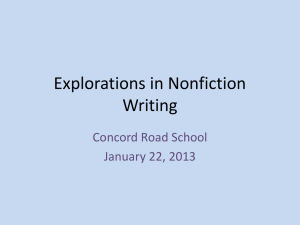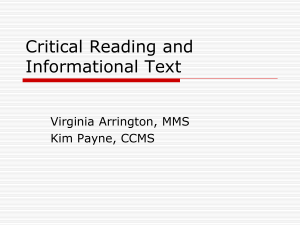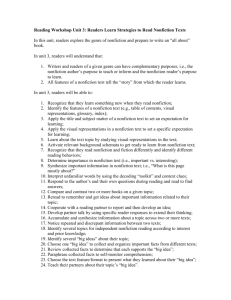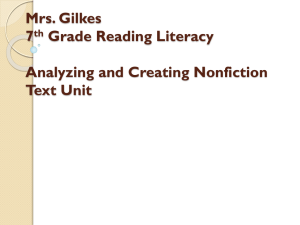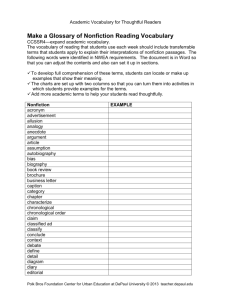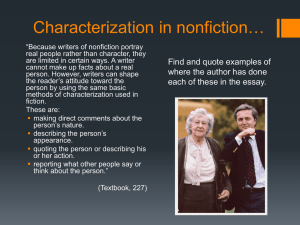Introduction to Text Structures
advertisement
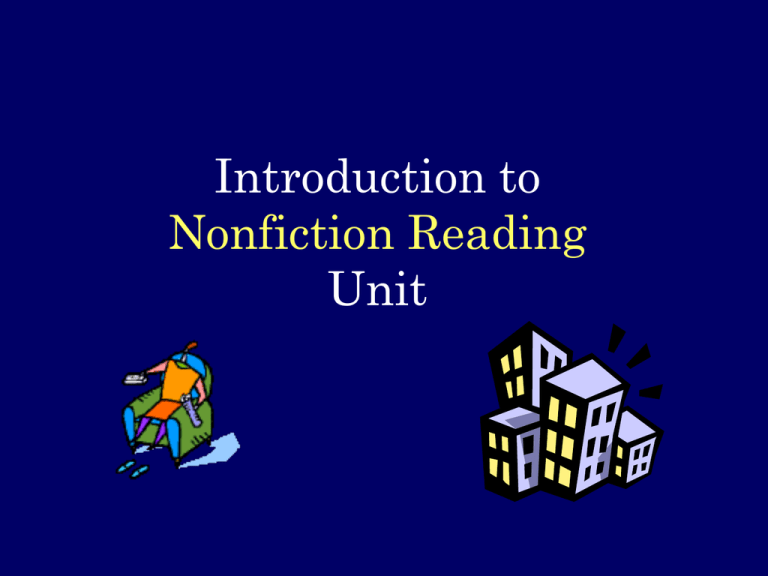
Introduction to Nonfiction Reading Unit Essential Questions • When our curiosity is raised about a topic how do we learn more about it? • How do capable readers make sense of nonfiction text? • How do responsible readers judge the accuracy of nonfiction text? • How do we read nonfiction text to become aware and empathetic to the needs of our community? Enduring Understandings Students will understand that . . . • Readers read nonfiction to satisfy their curiosity about the community they live in. • Capable readers choose specific strategies to make meaning of nonfiction text • Responsible readers are able to make better personal choice when they evaluate the accuracy of information in a reading to determine the validity of the writer’s view point. • Reading nonfiction text brings awareness and empathy to the individual reader of the needs of others in their community. So, why are we doing this? Practicing nonfiction reading by studying text structures can help us… *Read faster* *Understand better* *Remember longer* Before Reading Strategies (1) Access Prior Knowledge *What do you already know about the topic? (2) Examine Text Features * title, bold faced words, italics, headings, graphics (3) Predict the Text Structure of the article *hint: you can find useful clues in the title! (4) Determine your reader’s purpose and (5) determine your reading rate Reader’s Purpose People read for different reasons. -For example, you may read a horror story to be entertained. -Or a history of World War II to learn more about the subject that interests you. When you read, it is often helpful to set a purpose for reading, or determine what you’d like to get out of a piece of writing. To get an idea of that purpose, try asking yourself questions that begin with who, what, when, where, why, and how. Reading Rate • Each type of reading has a different rate. – An exciting novel is a quicker read than a text in biology. • You should adjust your reading rate depending on the type of text that you read. • Look at the chart on the next slide to determine where a newspaper article would fall. D E C R E A SE B A S E IN C R E A S E Mode Purpose Rate Rate range 1. Analytical reading (legal documents, persuasive essays, directions) To analyze information for inference, language, tone, bias; to evaluate logic and writer's craft. Usually the slowest rate. Varies with complexity of material. May require more than one reading. 150250 wpm 2. Study reading (textbooks, newspapers, magazines) To learn, synthesize, and retain information; gaining complete understanding of text material. Rate varies with amount to be learned and type of material. 150300 wpm 3. General reading To read as a leisure-time (newspapers, activity for pleasure and magazines, novels) general information. Rate varies with material, purpose, and familiarity. 250500 wpm 4. Skimming (initial research) To get a general idea of the material and some details; to get a mental outline of material's organization. Can be twice as fast as general reading rate. 5001000 wpm 5. Scanning (phone numbers, airline schedules) To locate specific information and answer questions as quickly as possible. Fastest rate with no specific wpm determined. 1000+ range During Reading Strategies • Connect to Community • Predict • Infer • Annotate/Summarize What is a text structure? • A “structure” is a building or framework. • “Text structure” refers to how a piece of text is built What is a text structure? • Builders use different structures to build and construct different things. • A skyscraper and house, for example, would require 2 very different structures. What is a text structure? • Just like architects, builders, and construction workers, writers use different structures to build their ideas. • Each text structure communicates ideas in a different way. Text Structures • Description – presenting a main idea and then offering several supporting details. • Compare/Contrast – examining the similarities and differences of more than one topic. • Problem/Solution – explaining a problem and offering solutions. • Cause/Effect – explaining how one event leads to another. Accuracy of Information • What is Accuracy? – the condition or quality of being true, correct, or exact; freedom from error. • What would affect Accuracy of Information? – – – – Credibility – author’s credentials Validity – well grounded; justifiable Balanced Facts – impartiality, looks at both sides Source of Publication – credible reputation, current, & purpose for publication Unit Activities • Most of the reading people do is nonfiction reading. • During this unit we will be examining the nonfiction text structures through magazine, newspaper, and internet articles, practice reading strategies, and develop skills to help us determine the accuracy of the information that we consume. • Have fun reading! • Some information from this presentation was adapted from and/or inspired by the Power Point presentation, “Understanding Text Structures,” by Emily Kissner. • Follow the links to find the original information: • http://www.slideshare.net/elkissn/understandingtext-structures • http://www.teacherspayteachers.com/Product/Un derstanding-Text-Structure-Powerpoint


